IPL or Laser? What’s the difference between laser and IPL (Intense Pulsed Light)? IPL and laser hair removal are both long-term procedures for reducing hair growth.
They work in similar ways, and can both be very effective. Not only do they prevent hairs from re-growing, but both treatment methods can also significantly reduce the growth speed of remaining hairs, as well as hair thickness.
Both laser and (IPL) intense pulsed light use light to heat the hair follicle and prevent regrowth. However, the technology used to deliver the light is really quite different – with the key difference being the kind of light itself.
If you’ve been looking at treatment options for permanent hair removal then you have probably come across both laser hair removal and IPL and are wondering what the difference is.
Nowadays you’ll find a wide range of devices and salon services for light-based hair removal. All methods will leave your skin smooth and hair-free, yet how do you decide between laser and IPL (Intense Pulsed Light) hair removal methods? Is it necessary to always go to a salon or can do it yourself at home is just as effective?
Read on as I show you the main difference between laser and IPL
What is IPL and how does it work?
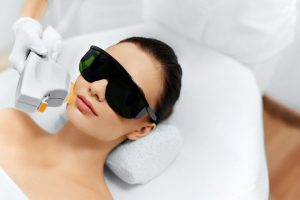
As we all know, IPL stands for Intense Pulsed Light. It uses a source of broad-spectrum, visible light. This light is specially controlled to remove shorter wavelengths and devised to target specific structures.
Intense pulsed light (IPL) is not monochromatic, meaning that IPL has many different colours and only a small percentage of these are effective in the treatment of hair reduction.
IPL is specifically designed to target the melanin pigment in the hairs, while in other uses such as the treatment of spider vein it targets the haemoglobin in the blood during the hair removal process.
The light energy is then absorbed, transferring as heat energy which warms the hair, causing damage to the follicle.
IPL machines typically use a range of wavelengths from 500 – 1000 nm. As these wavelengths are exposed to the skin, there is no ability for the light to discriminate between chromophores within the skin.
Due to the broad spectrum of light, obtaining sufficient energy to destroy certain deep targets such as hair is often challenging. So we can say that Intense pulsed light is not so intense…
IPL devices are not lasers. These devices produce a broad spectrum of wavelengths (like a light bulb) and cannot be focused to a concentrated beam
A range of different wavelengths is dispersed at a variety of depths only some of these are effectively absorbed by the hair follicle, causing substandard results and increasing the risk of burns.
IPL is not coherent and is not reinforcing making it less effective in the treatment of hair reduction.
IPL is not collimated and is therefore quick to spread out making it less effective in the treatment of hair reduction.
What are the Benefits Of IPL Hair Removal?

Why will you want to choose an IPL over Laser treatment? The benefits and pros, of course.
We’ll start by considering how treatment times is quicker compared to laser. IPL may also be considerably cheaper, but you may find that you need more sessions to achieve the same results.
Another is the IPL broad-spectrum light, this makes it usable in different ways. It can be used to treat a variety of different skin conditions very successfully.
It can also be altered specifically to match different skin and hair types within a treatment type. For example, a variation of IPL called VPL, which stands for Variable Pulsed Light, has been developed. VPL enables the user to modify the settings of the light pulses to best suit the skin and hair they are aiming to treat. This is because the developers recognize that not only do different skin tones have different requirements for light-based hair removal devices and also that thick, course bikini line hair will require different treatment to thinner arm hair.
As broad-spectrum light naturally spreads out, the coverage of IPL hair removal devices is greater than laser hair removal devices. It, therefore, may mean that treatment times may be quicker like I’ve said earlier. Since because larger areas can be treated at once.
Our recommended Best IPL machine for your use
If you’ve decided to go for IPL, these are the best product you can ever find as long as light-based hair removal is concerned.
Braun Silk-Expert IPL 5004 Hair Removal System
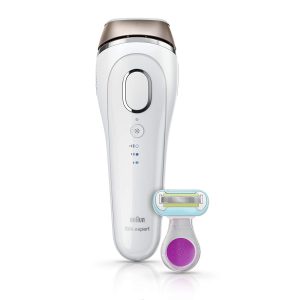
About product
Only Braun Silk-expert has the unique SensoAdapt skin tone sensor which continuously reads your skin tone at an astounding 80 times per second.
It works beneath the skin’s surface by targeting the melanin in the hair follicle, helping to break the cycle of hair regrowth. With continued, regular use, it helps prevent unwanted hair from reaching the skin surface.
Reasons to buy
The Braun Silk-Expert IPL provides fast treatments suitable for large parts of the body such as legs or arms. A leg or arm can be treated in just 8 minutes, without compromising on effectiveness. It also offers 10 energy levels, so you don’t have to compromise comfort while effectively removing hair. With 300,000 flashes, this home laser hair remover will last you a long time, before the light cartridges require replacement.
Braun Silk-expert is a newer option among IPL devices. The Braun Silk-expert’s IPL system can result in permanent hair reduction in as little as four treatments.
Pros
- Effective and reducing hair and regrowth
- Fits well in hand
- Fast treatment times
- Automatic skin sensor adjusts on the fly
Cons
- It still hurts
- Pretty spendy compared to others
- Some complaints about short shelf life
- Can be difficult to use on the chin and upper lip
Philips Lumea BRI9656/60 Prestige IPL
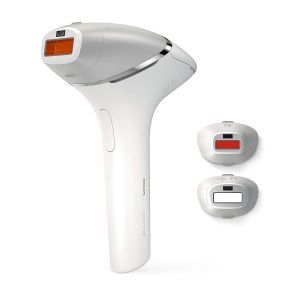
About product
This Device Has 2 Treatment Modes:
You can choose between the “Stamp and Flash” and “Slide and Flash” modes. Press and release the trigger for a single flash, or press and hold the trigger as you glide the device down your skin. We found that the stamp and flash were better for curved areas, such as underarms, while the slide and flash mode was better for larger body areas, such as legs.
This IPL device is the best all-rounder hair removal machine. It includes 4 Smart Cartridges for reducing unwanted hair on your face, legs, body, bikini and underarm areas, which are all curved to suit different areas of your body, to optimize skin contact, and therefore the results that you see.
The Smart Skin Sensor ensures you use the outlet properly by glowing when it is sufficiently placed against your skin. It had the best skin sensor technology of all the devices we tested because if it were only half covered, it didn’t light up and it also appeared to tell the difference between skin and other materials, so it didn’t just light up when covered.
Reasons to buy
A feature I particularly liked about this IPL hair removal devices was the different cartridge options for different areas of your body.
The cartridges are very quick to install and they communicate with the computer in the handset so that it knows which one is connected. The technology then adapts the settings to optimize your treatment.
Slightly convex to help you treat your armpit area. Flat body with an extra filter to precisely treat your upper lip, chin and sideburns. Slightly concave for large areas like your legs, arms and tummy. Slightly convex with a bikini filter designed to treat coarser hair
The computer is clear to read and you can use it to alter the settings. The device itself is relatively heavy, but you can still manoeuvre it with ease, and it feels well-built and balanced. It is also quiet and you can use it both corded and unplugged.
One reviewer says:
“The flashes didn’t hurt me as such, they felt warm, with a little snap. I did find, however, that it was more uncomfortable when the hairs were longer”
Pros
- 4 intelligent treatment caps
- Can be used anywhere on the body
- Skin sensor
- 2 modes
- Simple interface
- Works alongside an app
Cons
- A long pause in between flashes on “Slide and Flash” mode
- Heavier than other models
- Unclear whether it is FDA-cleared
What are the most common side effects of IPL treatment?
While virtually all cosmetic procedures carry inherent risks, it’s possible to greatly improve your odds of a successful outcome and avoid IPL side effects by:
- Seeking out a qualified expert to administer all of your IPL treatments
Carefully follow all pre and post-treatment instructions and guidelines - Before seeking out treatment, it’s also important to make sure you’re a good candidate. Generally speaking, the best candidates are healthy and possess realistic expectations.
- If you are currently pregnant, taking certain skin medications like Accutane or Isotretinoin, or have an active skin infection – you probably won’t qualify for IPL treatments at this time.
Anyway, Some of the most common IPL side effects include:
- Redness
- Swelling
- Minor Bruising
- Itchiness
- Peeling
- Scabbing
Lets now move to the next phase of the article – Laser hair removal.
What is Laser hair removal and how does it work?

Laser hair removal works with the help of high-heat lasers or intense pulsed lights (IPLs) that dissolve hair and temporarily disable hair follicles. That way, the follicles won’t be able to produce new hairs for up to several weeks.
Chances are you probably have already heard a lot of information about laser hair removal as it is becoming everyone’s favourite way of getting rid of unwanted hair, and the results are much longer-lasting than waxing, plucking, and other procedures. It can even prevent patches from growing back.
If you’re tired of shaving, tweezing, or waxing, you might consider other more permanent methods of hair removal. Laser hair removal offers the longest-lasting results. Though not completely permanent, you might go weeks without having to redo your treatment.
It has really become quite the popular choice for getting rid of unwanted hair as of late. The good news is that it is a semi-permanent solution to hair reduction
What are the Benefits Of Laser Hair Removal?

Now, from my brief explanation above, we can deduce that laser hair removal devices can focus light down into the pores of the skin, getting closer to the follicle to treat it and ultimately prevent regrowth. This underscores The nature of lasers.
Hence, laser hair removal can achieve much quicker results than IPL because single hairs are heated to damaging temperatures quicker. Therefore, you may need fewer treatments of laser hair removal to achieve the same results.
The nature of lasers being more focused, smaller areas of light mean that they are more suited to treating people with darker skin because they greatly reduce the risk of burning compared to IPL. Having said that, some IPL systems are still suitable to be used on darker skin.
Laser hair removal can be more suited to people who have darker skin. No doubt.
You ask why?
Well, this is simply because darker skin also absorbs more light than paler skin due to the amount of melanin (pigment) it contains, like darker hairs absorb more light than paler hairs. Therefore, there is a risk that the darker skin can be heated up.
Our recommended best Laser hair removal machines for your use
If you’ve decided to go for Laser Hair removal, these are the best products you can ever find as long as light-based hair removal is concerned.
Tria Beauty Hair Removal Laser
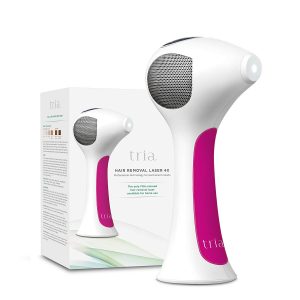
About product
The Tria laser costs just a fraction of what you’d pay for professional treatments from a dermatologist. If you’re looking to remove lighter hair colours such as naturally white, blonde, red or grey, the Tria might not be a suitable choice.
The Tria Hair Removal Laser 4X is an FDA-cleared at-home hair removal laser. It is specially designed with advanced features to deliver professional, permanent results and laser-smooth skin from head-to-toe.
It uses professional-strength laser hair removal technology, preferred by nine out of 10 dermatologists, to deliver 70 percent hair reduction within three months.
Reasons to buy
faster treatment times, a digital display and a pulse counter to make sure you are operating it correctly to get the best possible results.
Because even at-home laser hair removal can be harsh on your skin, Tria Beauty Finishing Serum helps rejuvenate your skin after each treatment.
It targets the pigment in your hair and then permanently disables the hair follicle’s ability to regrow hair.
These hair colours simply will not absorb enough of the laser’s energy to disable the hair follicle.
Pros
- Effectively removes hair
- Easy to use
- Far less expensive than professional laser treatments
- Automatic settings
Cons
- It hurts
- Doesn’t remove blonde, white, grey or red hair
- Not suitable for use on areas with tattoos
- It takes time and patience
DEESS Series 3 Plus

About product
It is very easy to set up and has a single button for selecting your energy setting and for triggering the flashes. It has 5 intensity levels which are displayed by five lights on the edge of the device. Pressing the button will alter the intensity level unless it is pressed sufficiently against your skin, in which case it will emit a flash.
You can also buy extra heads, such as a skin rejuvenation head or acne lamp. It has a capacity of 350,000 flashes and is FDA-cleared, with results comparable to those seen in salons.
Reasons to buy
I particularly liked that this model came with glasses, it can be used when trying any other products. You know, it’s important to protect your eyes as the flashes are intense.
The DEESS Series 3 needs to be plugged in to work, but its cable is long enough so it doesn’t limit you, and you get the benefit of consistent power output whenever you need to use it. It is shaped similarly to the Braun Silk Expert, so it is comfortable to hold, but not quite so easy to reach tricky areas.
The DEESS Series 3 Plus is another handheld, corded laser hair removal device. It comes in several different versions; some are just colour variations, while others include extra heads, but all the kits include safety glasses.
Pros
- Lightweight
- Many options available
- Includes safety glasses
- More treatment caps available
- Can get replacement cartridges
- 5 intensity settings
- 350000 pulses
- FDA-cleared
Cons
- Single-button control
- Harder to use on tricky areas
- The corded design may not suit some users
What are the most common side Effects of laser hair removal treatment?

I’m always frank about my contents. Having chosen the best laser product, It is equally important to be aware of common side effects that come with laser hair removal treatment.
Most side effects are minor and temporary. Anyone experiencing lasting side effects should consult their dermatologist.
Changes in skin colour
People with lighter skin may be more likely to experience darker pigmentation changes. People with darker skin tones may be more prone to lighter pigmentation changes. These changes tend to fade away over time, and the skin returns to normal.
Some people may notice minor colour changes to the treated area of skin. It may get slightly darker or lighter, following laser hair removal.
Crusting
Crusting can sometimes lead to scabbing or scarring. By taking care of the treated area after laser removal, such as by using a moisturizer, a person may prevent any lasting issues from this treatment.
Some people MAY experience skin crusting in the affected area. This is typically a minor issue but can be inconvenient.
Risk of skin infection
As with other cosmetic hair removal methods, damaging hair follicles with a laser can create an infection risk.
The affected area should be treated as a wound while it heals. People should report any signs of infection to a dermatologist.
Also, they should not apply over-the-counter (OTC) antibiotic creams to large areas of skin if an infection arises.
Eye injury
Both the person receiving the treatment and the practitioner should wear protective eye equipment to help prevent injury while the procedure is carried out.
The hair removal procedure involves the use of powerful lasers. This means there is a risk of potentially serious eye injury, especially when a practitioner is working on a person’s face.
Redness and irritation
Laser hair removal damages the follicles of the targeted hairs. The body reacts to this, and many people experience redness and irritation in the affected areas. The skin may tingle or feel tender, and may even appear to swell slightly.
Irritation should ease after the initial reaction, usually within a few hours of the treatment. Swelling and redness may respond well to ice packs or a cool bath.
The symptoms are usually short-lived. The affected area may look similar to skin that has just been waxed or plucked. Some dermatologists use a topical anaesthetic to reduce how much a person’s skin reacts to the process.
Similarities between the IPL and laser
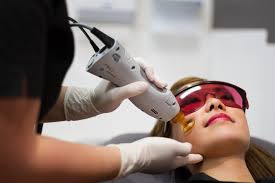
It may seem that the difference between the two can be thought of as six of one and half a dozen of the other. The devil is in the details. Here are the similarities between IPL and Laser
- Both methods target the melanin in the hair follicle and permanent results can be expected from both.
- In a medical setting, both techniques are used to treat a variety of skin and eye conditions.
- Either method reduces hair growth, but neither destroys all hair follicles permanently. While pursuing either course of treatment, you can continue shaving normally but should be careful of too much sun exposure.
- Both are similar in terms of their working principle: using light to heat up hair roots, and thereby destroying the follicle without harming the skin. This means that instead of the hair soon grow back, as with waxing or shaving, it’s removed permanently (although new follicles will continue to develop over time).
- Both can be done at either a clinic or at home, and both require several treatments spread over months for best results.
- Recently, both have also found application in a process called photorejuvenation, where many of the visible signs of ageing are reversed by actually triggering skin cells to behave as if they were younger.
Knowing all this, however, and in certain cases one specific hair removal method is most definitely superior. This brings us to the major differences between both.
Major differences between the IPL and laser

The key difference between laser and IPL is the type of light. IPL (Intense Pulsed Light) is a broadband pulsed light source, whereas laser is a monochromatic coherent light source
Due to the way the technologies themselves work, laser and IPL treatments vary in terms of the following…
Treatment time
Because the beam of light used in laser treatments is very concentrated, laser devices have a very small treatment window. Thanks to the broader flash of light used in IPL, IPL devices feature a bigger treatment window and so can cover a much larger area at once, meaning a much faster treatment time in comparison to the laser.
Pain rating
The single, more pointed beam of light used during laser treatment is often reported to be more painful than IPL treatment.
Cost
Laser light is expensive to generate, and so, in salons especially, laser treatment comes with a hefty price tag whereas IPL is often much more affordable.
Longevity of results: As a trade-off for the increased price tag and pain level, the results from laser treatment can mean fewer top-ups are required between sessions. But, as with any kind of light-based hair reduction, you’ll always need to continue with top-up treatments to stop hairs from growing back.
Safety
Laser light is very powerful and can even be dangerous. Because of this, at-home laser hair removal devices use significantly reduced power, especially in comparison to their expensive salon equivalent. The bonus of IPL treatment is that it’s much safer to use as the light is less concentrated, and so can be used at-home risk-free for long-lasting results.
Professional laser treatment is working more selective and therefore the very high energy will focus on the hair follicle rather than the surrounding skin. Therefore Professional laser will lead to fast results as well as being suitable to darker skin tones. Energy, frequency and hair colour are all determining factors in the efficacy of the treatment, while the light source, whether it is a laser or an intense pulsed flashlight plays a minor role.
Which one is better for me?

Choosing between IPL and laser treatment is a personal decision. Your skin tone and hair colour can affect the results you can achieve with both laser and hair removal, so it is important you understand which is best for you, so you can achieve the outcomes you desire.
You should consider your skin and body type and the amount you wish to spend and how quickly you want to see results.
One of the primary objectives for light-based hair removal using either laser or IPL is to achieve this critical temperature in the hair follicle whilst at the same time not heating up the surrounding skin to a temperature that could cause damage such as a blister. This is achieved by careful control of the amount of light output.
Lasers produce a very specific type of light consisting of one wavelength or colour of light all going in one direction, which creates a single beam like a laser pointer. IPL devices produce a wide range of wavelengths of light to produce a single white flash.
This light is closer to natural light and can appear with an orange/red glow when the device is flashed against the skin, like a camera flash.
Laser and IPL hair removal both work on the same principle. That is that light energy is absorbed by areas of high pigment such as hairs, which are therefore heated up. The heat damages the follicle, slowing hair growth and even preventing it completely.
The main difference between IPL and laser hair removal devices is the light source used. IPL uses broad-spectrum visible light whereas laser hair removal utilizes the properties of a laser.
Some reviewers say Laser technology is simply much more effective and achieves substantially better results than IPL with most clients achieving optimal results of permanent hair removal of 80% or greater after four to eight treatments.
But really! IPL can give the same standard of results as laser-treatments, as long as you follow the prescribed treatment regime – and keep on top of top-up treatments! In return for your dedication to your regime, you can save time, money and endless trips to the salon, completing your treatments in the comfort of your own home. What’s not to love?
In fact, IPL is a cheaper, less effective technology for reducing body hair.
Lasers are far more precise and can selectively target dark, coarse hair while leaving the surrounding areas undamaged.
Each laser pulse takes a fraction of a second and can treat several hairs at a time.
Laser settings can be adjusted to suit your specific skin tone and hair colour.
Lasers have the capability to safely treat all skin colours, whereas IPLs can cause burn on darker skin types.
However, IPL machines do have an important place in the treatment of skin. IPL provides adequate treatment for skin problems such as superficial pigmentation, redness, and capillaries, but it is not suited to hair removal. In addition, these devices are not suitable for darker skin.
The main difference between laser and IPL for hair removal lies in the technology that each use to generate light as well as the different properties of light being used.
It is important to understand however how areas of skin which have higher pigment, such as freckles and moles, as well as darker skin generally, will also absorb more light energy and heat as a result. This may affect which hair removal method is best for you.
It’s a wrap up on ‘IPL or Laser treatment?’!
Many patients and clients of both IPL and laser hair removal achieve very successful results, but to attain the best results, it is important to decide which method is more suitable for you. I hope that this guide has been able to, not only inform you but also help you with the best product on whichever hair removal method you have chosen. Hit the comment box if you’ve got any questions.

